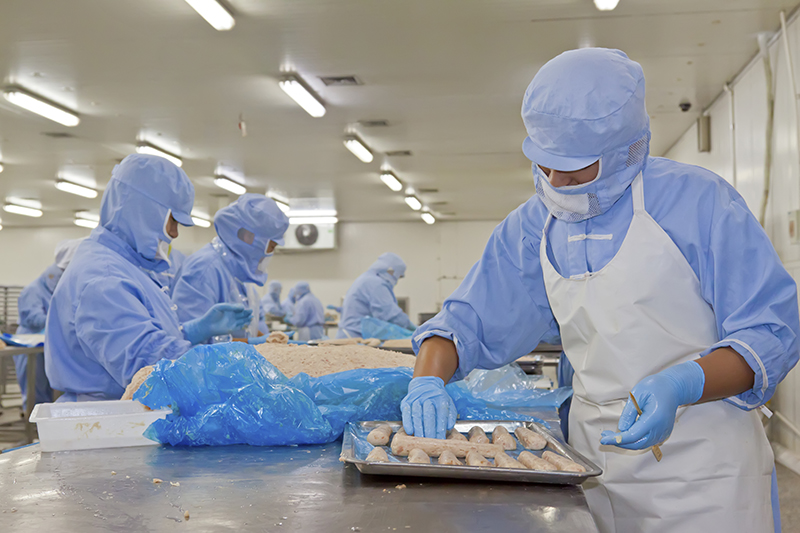Seize the Competition by Improving Sanitation

For consumers and manufacturers, product quality and cleanliness are a preeminent priority. Product recalls resulting from manufacturing errors in sanitation often warrant national headlines and cause widespread mistrust and panic among consumers.
After a tumultuous spring and summer, Blue Bell Creameries, a Texas-based ice cream manufacturer, will be restocking its products in select grocery store freezers in five phases. The popular brand was forced to recall its products due to Listeria contamination, which has been blamed for the deaths of three people.
Learning from these instances can greatly reduce the number of sanitation-related issues in the future. Investing in sanitation not only increases safety but does wonders for performance and efficiency.
How can sanitation be a competitive advantage and not a troublesome necessity? It’s all about OEE.
While not investing in sanitation may save you a little money in the short-run, neglecting it can cause exponentially larger costs down the road, including elevated food scrap, equipment reliability failures, excessive non-value adding to production time, expensive recalls, remediation costs, potential legal liability, and destroyed consumer trust.
A focus on Overall Equipment Effectiveness (OEE) will increase capacity without investment or additional resources, and it does not need to be overly difficult or expensive. However, OEE management does require detailed process analysis, process rethinking, reconstructing of resource assignments, and installation of management control and reporting systems. When equipment is scheduled to run, it’s running at the correct rate, using the right number of resources and at the right level of quality. This will not only boost the efficiency of your operation, but the safety and quality of it as well.
An Important Piece of the Puzzle
Adopting lean techniques into your sanitation plan is an effective and efficient way to improve process time. With this approach, you can determine:
- How to best execute work
- How much time it should take
- Who should do it
- What specific equipment or tools are needed
- Which materials and PPE (Personal Protective Equipment) are necessary
- What testing is required
Using LEAN will allow you focus in on three essential areas: the elimination of waste, reduction in variability and reduction of inflexibility. When these factors come together, work can be completed in a standardized, efficient and sanitary manner.
Study. Streamline. Standardize.
Study. To incorporate, improve or ensure sanitation, the first step is to evaluate what you’re working with. Take the time to examine existing protocols and contracts. Conducting a detailed study of the current processes can help you define the areas that need work, which may include equipment effectiveness, supervisory staff and materials used.
Streamline. Once you obtain the initial result of the study, goals and plans can be determined to streamline the process and make everything run more efficiently. It is not unusual to discover at least 30% of non-valued time within the existing process, mainly due to poor planning, poor coordination or the use of overly cumbersome methods.
Standardize. After creating a plan to improve effectiveness and sanitation, swift and certain implementation of these ideas are critical to maintain commitment and realize results. With a detailed plan, sanitation of machines and other supplies can be executed in an exact, timely fashion.
Placing Sanitation Operation First
One of the biggest mistakes that can be made in manufacturing is viewing sanitation operations as secondary in importance. This attitude can lead to all kinds of oversight and carelessness, which can cause costly mistakes. Clear expectations, clear roles and responsibilities, and measured performance are the hallmarks of well-executed operations and an effective way to make sanitation a priority.
Dramatic Improvements, Significant Savings
Making these changes to increase efficiency and sanitation have yielded dramatic improvements for manufacturers. A large U.S. food manufacturer installed this system in five of their plants and quickly cut costs while boosting productivity. One of the plants was able to repatriate production outsourced to a co-manufacturer at a savings of approximately $500,000. Another replaced its entire 50+ person sanitation crew with a subcontract cleaning crew, reducing its labor cost from $22 to $11.47 an hour, while at the same time increasing the work effectiveness of the crew and performing 15% more sanitation work within the same time frame.
Manufacturing isn’t only about quantity; it involves ensuring a level of quality that builds consumer loyalty and efficiency. When your product potentially poses risk for the consumer, it also poses a danger to your business and its success. Remember, you don’t have to risk using unsanitary methods for the sake of saving money or increasing efficiency. In fact, sanitation and efficiency are easily attainable when they are brought together in a strategic plan. Putting in the time and dedication to create an effective sanitation plan will help you avoid negative consequences and bring you to the top of your game. Stay clean.